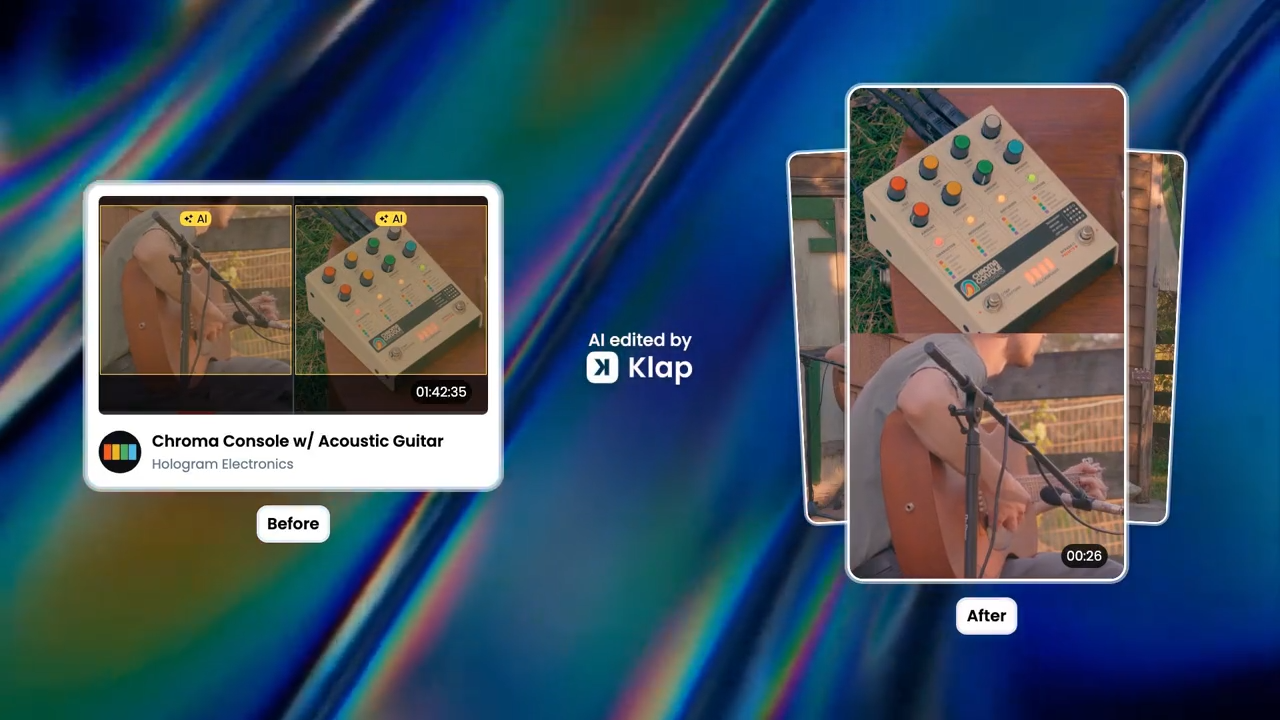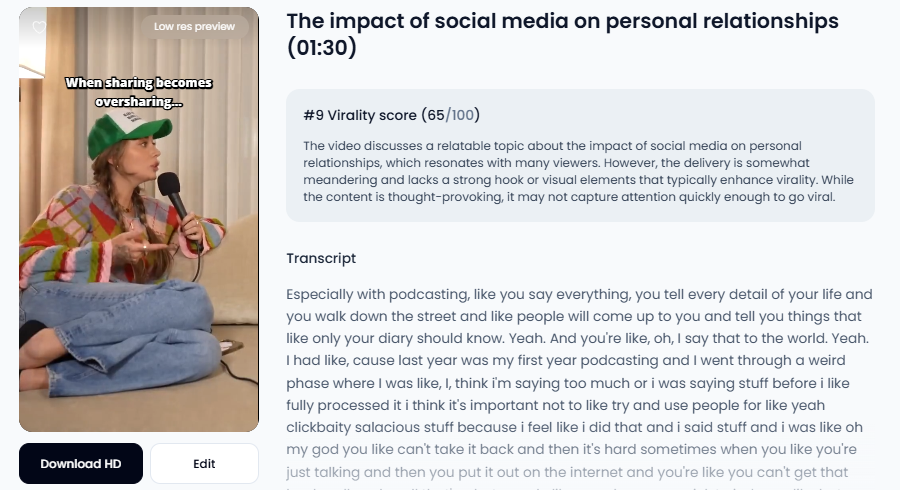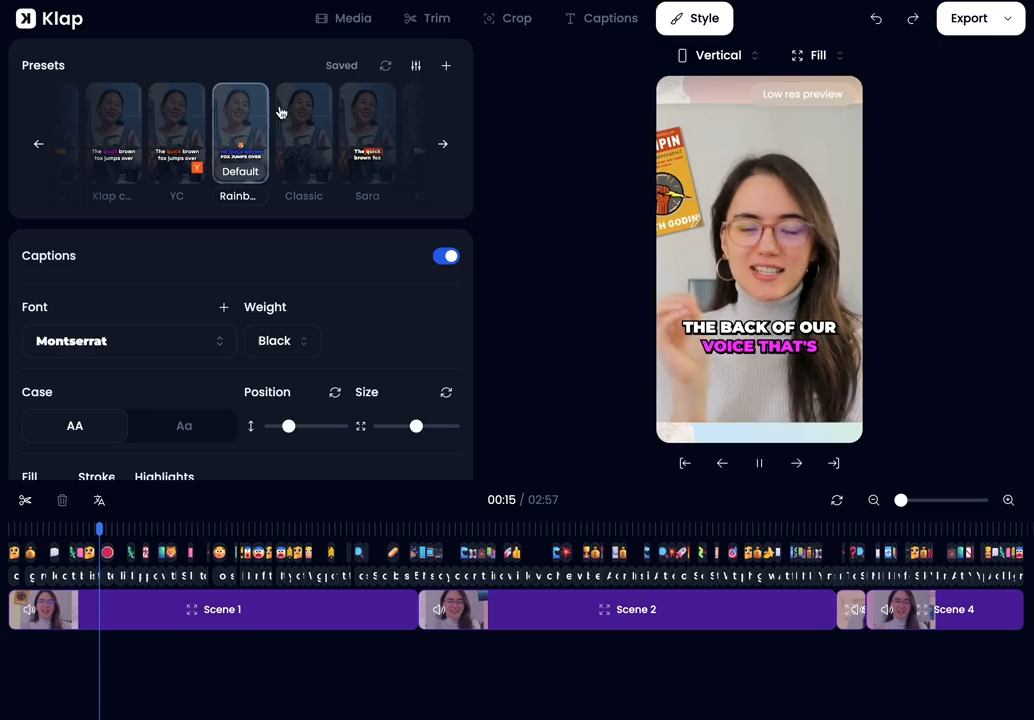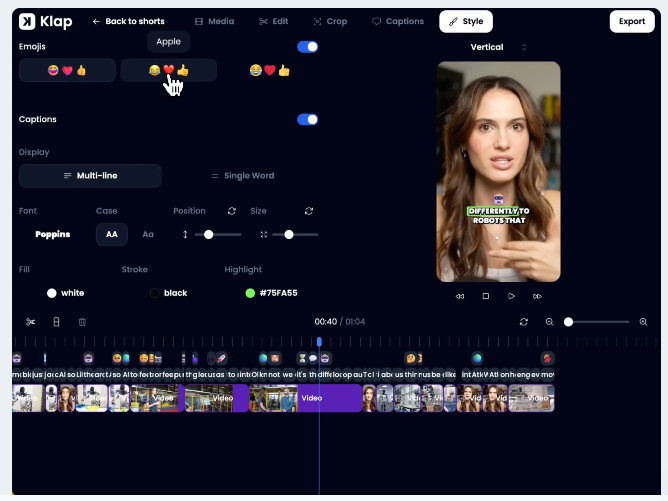How to Grow a YouTube Channel: 5 Proven Steps That Work
Content Creation
Quick Summary
This guide shows you how to grow a YouTube channel with five practical strategies, from defining your niche to turning long videos into Shorts using Klap. Learn why growth matters, what slows creators down, and how to scale smarter with AI tools. For deeper tips and tools, check out more resources on our blog.
Struggling to Grow Your YouTube Channel Despite Posting Regularly?
Growing a YouTube channel takes more than just posting regularly. Between brainstorming ideas, editing long videos, writing compelling titles, and trying to please the algorithm, even experienced creators can feel stuck. You’re doing the work, but your growth feels slow.
That’s where strategy and smart tools come in. With the right systems in place, you can stop overthinking and start making content that consistently reaches the right viewers. From optimizing for search to repurposing videos into Shorts, there are practical ways to scale without burnout.
In this Klap guide, we’ll break down five proven steps to grow your YouTube channel, covering content planning, audience targeting, retention tactics, and how our AI tool helps you create more, in less time.
Why Listen to Us?
At Klap, we’ve helped over 1.2 million creators generate 2.5 million+ viral clips from their long-form videos. We work with top creators and brands daily, giving us deep insight into what drives real growth. That’s why we understand what drives YouTube growth and how to help creators achieve it faster.

What Is the Role of AI in How to Grow a YouTube Channel?

AI is quickly becoming a key part of modern YouTube growth. For creators who want to scale without burning out, AI tools streamline time-consuming tasks like editing, clipping, subtitling, and performance analysis.
Instead of manually scrubbing hours of footage, AI platforms like Klap can automatically detect high-engagement moments, reframe content for vertical video, and add bold, stylized captions that boost retention. This means you can turn one long video into a batch of Shorts optimized for YouTube, TikTok, and Reels, all without starting from scratch.
AI also helps to:
- Identify content patterns that lead to higher click-through and watch times
- Suggest better titles and thumbnails based on audience behavior
- Translate and localize videos for wider reach
- Predict what segments have viral potential (before publishing)
The result? Less time editing, more time creating, and more opportunities to grow across formats and platforms.
How to Grow a YouTube Channel in 5 Actionable Steps
In this section, we’ll break down five clear, effective steps to help you grow:
1. Define Your Niche and Target Audience
Growth starts with precision, knowing exactly who you're making videos for and why they’ll care.
Skip vague “lifestyle” angles. Instead, niche down with purpose. Focus on a specific audience, problem, or interest that gives your content clarity and direction.
Use these filters to narrow your niche:
- What unique perspective or expertise do you offer?
- Which audience is underserved in your category?
- What topics do you consistently have insights or stories about?
Once you know your niche, define your target viewer. Think beyond demographics. What are they searching for? What frustrates them? What keeps them watching?
Every decision, from content ideas to thumbnails, should align with what this audience values most. You're not just chasing views; you're building a content engine that speaks directly to a specific group, again and again. That’s how you turn traffic into loyal growth.
2. Create High-Retention, Valuable Content Consistently
Retention is the backbone of YouTube growth. If viewers don’t stay, the algorithm won’t push your content, no matter how good your thumbnail looks.
To improve retention, front-load value. Give viewers a reason to stay within the first 15 seconds. Avoid slow intros, vague openings, or off-topic rambling. Get straight to the point and structure your content to deliver payoff early and often.
Use data from YouTube Analytics to find drop-off points and rewatch spikes. This shows you what’s working and what’s losing attention. Build patterns from your best-performing segments.
Scripting helps, but don't over-polish. Viewers want clarity, not perfection. Use natural pacing and tonal shifts to keep the experience dynamic.

Batch production can also improve consistency, especially if you’re creating long-form videos that feed into Shorts. By turning each long video into multiple high-quality clips, you can maintain a posting rhythm without producing from scratch every time.
Key areas to focus on:
- Structure: Hook → Value → CTA
- Visual pacing: Use cuts, zooms, and overlays to reset attention
- Audio: Prioritize clean sound and minimal distractions
- Topic selection: Focus on problems people are actively searching for
Content doesn’t need to go viral. It needs to be valuable enough that your ideal viewer wants the next one, too.
3. Optimize Videos for Search and Recommendations
YouTube surfaces videos based on relevance, performance, and viewer behavior. Your job is to align each upload with how people discover content, via search, home, and suggested videos.
Start with a focused keyword. Use tools like TubeBuddy or native YouTube search suggestions to find what your target audience is actively looking for. Build titles around this, but keep them natural and curiosity-driven.
Thumbnails should contrast visually with others in your niche. Use bold, legible text and high-contrast visuals. The goal is clarity at a glance, not just visual appeal.
Structure your descriptions with key phrases early, but also make them skimmable. Add timestamps, CTAs, and supporting links.

To boost recommendations, increase session time. Link related videos using end screens and pinned comments. Group content into playlists to keep viewers watching.
Here’s a quick optimization checklist:
- Title: keyword + curiosity
- Thumbnail: contrast + clarity
- Description: relevant, structured, actionable
- Tags: support keyword variations
- Engagement: prompt comments and link next video
Treat optimization as a system, one that evolves with your data. Review, test, and adjust with every upload.
4. Engage With Your Audience and Build Community
Comments, likes, and shares signal value to YouTube’s algorithm and build stronger connections with your audience.
Start by replying to comments meaningfully, not generically. Prioritize early comments in the first 24 hours after posting, that’s when engagement has the most algorithmic weight.
Use pinned comments to drive action or start conversation threads. Ask direct questions in your videos that encourage specific responses, the more comment-worthy your content, the better.
Consider creating community posts or polls between uploads. These give you insight into audience preferences and keep your channel active.
Here are tactics to strengthen viewer connection:
- End videos with simple, low-effort CTAs (e.g., “Which part hit hardest?”)
- Mention frequent commenters or viewer suggestions in future videos
- Use playlists to show viewers you’re building a journey, not just content
Don’t chase vanity engagement. Focus on feedback that informs your content direction and builds loyalty, those are the viewers who stick around and share.
5. Repurpose Long-Form Content into Shorts Using Klap
Short-form content fuels discoverability. If you're only publishing long videos, you're missing a massive opportunity to reach new viewers across TikTok, Reels, and YouTube Shorts.
The key is to repurpose, not re-edit. You already have the raw material, interviews, podcasts, tutorials, but manually cutting them down is time-consuming and unsustainable.
This is where Klap becomes essential. It uses AI to analyze your long-form videos, extract the most engaging segments, reframe them for vertical format, and add dynamic captions, all in a few clicks.
Repurposing helps you:
- Multiply your content output without filming more
- Extend the lifespan of every video
- Reach audiences that prefer short-form formats
- Increase channel impressions and subscriber conversion
Strong hooks, fast cuts, and visual clarity matter more here than deep explanations.

Use data from Shorts performance to test topic angles, hooks, or moments worth expanding into long-form videos. Repurposing isn’t just about reach, it’s also a feedback loop for smarter content strategy.
Best Practices for Growing a YouTube Channel
- Start with One Format: Focus on either long-form videos or Shorts until you build momentum and then expand your content types strategically.
- Hook Viewers Fast: Grab attention in the first 15 seconds with a bold question, teaser, or strong statement to keep viewers watching.
- Stay Consistent: Pick a realistic posting schedule and stick to it. Growth comes from showing up regularly, not just going viral.
- Use Data to Improve: Watch retention, click-through rates, and comments to see what’s working and adjust your content based on results.
- Repurpose Smartly: Turn each long video into multiple Shorts with tools like Klap to increase reach without extra effort.
Let Klap Power Your YouTube Growth
If you want to grow a YouTube channel, it's not just about posting more, it's about working smarter. From defining your niche to optimizing and repurposing content, each step builds momentum. That’s where Klap comes in.
Klap helps you turn long-form videos into high-impact Shorts in just a few clicks. With AI-driven editing, automatic captions, and smart reframing, you can scale content output without extra time or effort, and reach more viewers across YouTube, TikTok, and Reels.
Start repurposing your videos with Klap and grow your channel faster!

